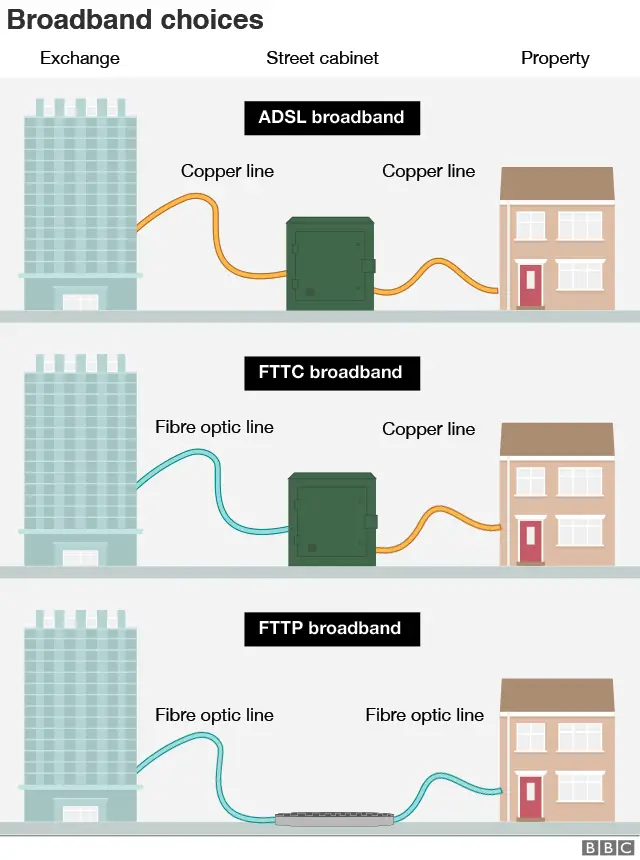
Its new and its fast, yet that seems to be only two things people know about fibre optic broadband. So why is fibre optic broadband being hailed as the holy grail of super-fast internet connections?
Heres an interesting fact for you a fibre optic wire is thinner than a single human hair. They are made from glass or plastic, which are designed to carry virtual information at very high speeds. Now are you ready to talk technical?
Do you remember when we thought we were the bees knees when we had ADSL broadband in our homes? Or even worse when we had to connect to the internet by dialling up. However, now the internet has been revolutionised with the introduction of fibre optic broadband.
The future of the internet is quick and bright, thanks to fibre optic broadband. In the past we only dreamt about faster internet speeds. However, it now estimated by the end of 2013, internet speeds will be tripled. On previous ADSL connections, we had access to speeds of 24Mbps maximum. However, now with fibre optic broadband, speeds of up to 100Mbps can be reached.
A fast connection may not be suitable for wireless routers and smartphones, some experts say. Whereas others have said there is no demand for fast internet speeds on devices and handsets such as laptops. This is where the real debate begins.
A high-speed internet connection may be great for your household if you enjoy catching up on your favourite TV show online, download a lot of music, games and films. However, the downside of fibre optic broadband is that it is not cheap.
How Fibre Optic Broadband Works
Signal can now be extended over greater distances with an improved frequency. This is as a result of improved bandwidth, which leads to quicker internet speeds.
Compared with ADSL, there will be less interference on a fibre optic connection, as it sends the information as light. Copper wires were used to send the information on ADSL connections, hence why it was a lot slower.
Pros of Fibre Optic Broadband
Superfast Downloads By the end of 2013, internet speeds are likely to reach 300Mbps. This is up from the current maximum speed of 100Mbps.
Speedy Uploads Files can now be uploaded to the internet at speeds of 30Mpbs; this is faster than ever before.
Multiple Users Many people can use the same line on a broadband connection without slowing the speed.
Cons of Fibre Optic Broadband
Price On average you will pay somewhere between £15 and £20 per month for a fibre optic connection. However, this can differ from supplier and month.
Availability Fibre optic broadband is currently being rolled out across the country. Therefore, only the most populated areas have access to it.
Fibre Optic Broadband The Different Types
Fibre optic connections still commonly use copper cables. The three main types of fibre optic broadband are FTTC, FFTP and FTTH.
FTTC (Fibre-To-The-Cabinet) Copper wires are used to send the information to the house. However, the information will be sent to a local exchange via a fibre optic connection.
FTTP (Fibre-To-The-Premises) A fibre optic connection will be sent to the premises. However, a copper wire will be used to send the signal to each individual room.
FTTH (Fibre-To-The-Home) The fibre optic connection comes straight to your home.
80% of fibre optic connections in the UK are through the FTTC. It is slightly slower than the FTTP and the FTTH connections. However, the FTTC connection is easier to maintain and is therefore one of the main reasons for such a high percentage use across the UK.
How fast is fast?
Currently, most fibre optic users are receiving speeds of wither 40Mbps or 80Mbps. Those on a 80Mbps connection will receive upstream speeds of 20Mbps, whereas those on 40Mbps connection will receive upstream speeds of either 10Mbps or 2Mbps. However, it is common to actually receive a slower connection. For example, it is quite normal to receive a maximum speed of 39Mbps when you should be receiving a 40Mbps connection.
Some retailers may offer the 20Mbps upload product speed with a 40Mbps downstream speed; this is achieved by capping the downstream speed in the retailers network. Not everyone will receive the maximum speed as it depends on the length of your phone line to the cabinet which is providing your broadband service.
Download speeds of 330Mbps and upstream speeds of 30Mbps are available if you live in an area with a FTTP connection.
Watching movies online, listening to music, sending e-mails are just some of the things that will be speeded up with a fibre optic connection. But just how much faster will they be?
| How long would it take to download? | Photo | Video | Album | Film | Every Friends Episode | |
| Basic Broadband (2Mbps) | 0.3s | 18s | 25s | 6m, 51s | 49m, 13s | 1 day. 13 hrs. |
| Fibre Optic Broadband (20 Mbps) | 0.03s | 1.8s | 2.5s | 41.1s | 4m, 45s | 3hrs, 48m |
| Proposed Speeds 2013 (300 Mbps) | 0.002s | 0.12s | 0.17s | 2.74s | 19.75s | 14m, 54s |
The Future of Fibre Optic Broadband
By the end of 2013 anyone receiving FTTC with speeds of 40Mbps is likely to have that increased to 80Mbps. FTTP is likely to increase to 100Mbps.
Due to complex geography signals in rural areas are poor. However, there could be a solution. A Fibre-Through-The-Air (FTTA) connection is being developed. Various platforms such as CPEs, radios, modems and antennas will be utilised to merge all the signals into one. This will boost the signal capacity and is similar to single fibre combining wavelengths. However, this is still in development and wont be available in the UK for a few years yet.
Fibre-like speeds and capacity are now available in certain rural areas in France. Bluwan have developed a FTTA scheme which offers multi-gigabit wireless solutions to rural areas.
